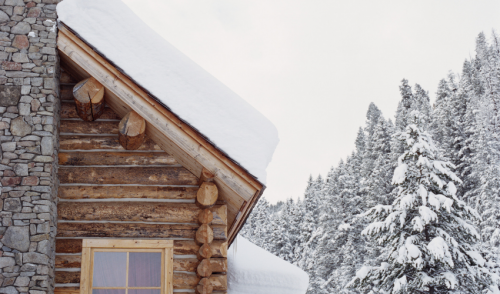Winter Checklist

There are many ways to winterize your home long before snow flies, but proper winter home care doesn’t stop with winterization. Throughout the season there are different steps you can take to keep your home snug and secure all the way through to spring.
How Winter Can Hurt Your Home
Winter can be a very damaging season with severe cold and temperature swings, blustery winds, ice and snow buildup on the roof and gutters, ice expansion in different crevices, water damage from burst pipes, and other potential problems. Whether you stay home all through the cold season, leave for the holidays or a winter break vacation, or head south for warmer temperatures until winter ends, it is important to have your home properly cared for even on the coldest days.
15 Items for Your Winter Home Care Checklist
No matter how severe your winters may or may not be, there are certain winter tasks that can keep your home in excellent condition during the cold season.
- Remove Snow and Ice Buildup Snow and ice will gradually accumulate on your roof and along your gutters. That weight can stress your roof’s structure, opening cracks that may cause leaks. Ice dams can lead to huge icicles that will bend gutters or could be hazardous if they break off. To solve these problems, remove as much snow and ice from your roof as safely possible. A roof rake is a great option to clear snow without getting on the roof, or you may be able to clear some from windows.
- Check Window and Door Seals Extra caulking and weather stripping around doors and windows should be done in the fall before winter arrives, but as temperatures fluctuate through the season, seals can loosen and permit heat to escape. Check seals several times during the winter to be sure they are still adequate, and touch them up as necessary to keep heat inside and cold outside.
- Keep the Fireplace or Woodstove Clean Nothing is cozier than a warm fire on a cold winter evening, but if you allow soot, ashes, and creosote to build up in your fireplace or stove, the heating will be less efficient and it could pose a fire hazard. Clean out ashes and transfer them to a metal bucket so they can cool thoroughly before being discarded safely.
- Check Safety Detectors Test smoke detectors and carbon monoxide detectors each month to be sure they are working properly, and change the batteries at any sign of unresponsiveness. These alert devices are essential for safety and should always be kept in top condition. If you aren’t sure about how they work, contact your local fire department for an inspection and tips.
- Beware of Pipe Freezing Risks Watch weather forecasts carefully and take extra precautions to protect pipes when a cold snap threatens. Leaving cupboards under the sink open to allow warmer air to circulate, turning the heat up a couple of extra degrees, or allowing a thin trickle of water to run are all ways to keep the water flowing and prevent freezing and breaks.
- Keep Floors Clean Sand, salt, and other anti-ice chemicals that get applied to roads and sidewalks in winter can cause stains, discoloration, and scratches to your flooring. Use a boot mat or tray in winter and clean the floors often to remove any debris before it has a chance to damage tile, carpet, and hardwood.
- Stay Stocked Up Severe storms can hit at any time during the winter, and it is crucial that you are always prepared with extra supplies of medication, batteries, candles, food, and other essentials, including a generator if necessary. Check your supplies regularly to be sure you have enough in case you are snowed in or the power is interrupted for several hours or days.
- Replace Filters Keep your furnace running efficiently by cleaning or replacing filters regularly throughout the winter, and be sure the vents and grills leading to ductwork are also cleaned. Not only will doing so protect this critical appliance, but it will also help lower your heating bills and minimize dust and allergens in the air.
- Check Trees and Shrubs for Damage Trees and shrubs, especially those with longer branches, can easily be damaged by heavy snow and ice buildup. If necessary, use a broom to brush off excess accumulation to help the plants keep their shape, or if there is already damage, trim the plants or tie them up to minimize additional harm before spring arrives.
- Check Outdoor Handrails If you have outdoor handrails to your home’s entrance, porch, or deck, check them regularly to be sure they’re still firmly secure. Snow and ice can cause fastenings to loosen and just when you may need the handrails when walking across a slippery surface, they could wobble or fail.
- Open Curtains and Drapes While window coverings can block drafts in the winter, they also block sunlight and prevent you from using solar heating as efficiently as possible. On sunny days, open curtains and drapes to let sunshine in not only for heating, but also for natural light that will brighten moods as much as it brightens rooms. Close them again at night to keep heat inside.
- Lubricate Sticky Locks Extreme cold can tighten locks and delicate mechanisms, and you may find yourself locked out of your home. Use a powdered graphite lubricant to loosen sticky locks, and consider lubricating doorknobs and hinges as well to be sure they all work properly.
- Hire a Snow Removal Service If you are unable to shovel frequently or will be away from home for long periods during the winter, consider hiring a snow removal service to keep the driveway, sidewalk, and walkways clear. This will prevent snow and ice from accumulating to dangerous levels, and will help you have a safer surface for walking. Furthermore, some communities may have laws about how frequently snow must be cleared on public walkways, and you will want to avoid any potential violations or fines by ensuring the shoveling is done appropriately.
- Clean Inside Your Home When you can’t get out to work in the garden or care for the lawn, it is the perfect time to tackle cleaning and organizing tasks inside your home. Use snowbound days as an opportunity to clean the fridge or oven, clear out a closet, wash the insides of windows, or do other cleaning tasks that always seem put off. This will help ease winter cabin fever and keep cleaning chores from piling up until spring.
- Keep Emergency Numbers Nearby Keep phone numbers for utility companies, police, home insurance, and other essential services updated and handy throughout the winter. While you always hope that you won’t need to use them, if something does happen you will be glad you had the information available to get the assistance you need right away.
Winter can be a hard season, but with proper care throughout the coldest days, your home will weather the elements with ease.

Comments